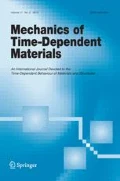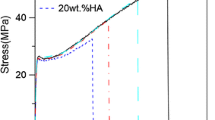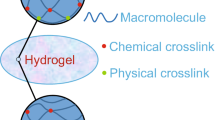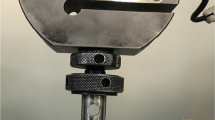Abstract
Nanohydroxyapatite reinforced poly (vinyl alcohol) (nano-HA/PVA) gel composites have been proposed as a promising biomaterial to replace diseased or damaged articular cartilage. In this paper, the logarithmic model and multimode Maxwell model were used to describe the stress-relaxation process of nano-HA/PVA gel bio-composites, respectively. The results showed that both models can precisely describe the stress-relaxation behavior of nano-HA/PVA gel composites and their maximum absolute errors are not in excess of 6 %. However, the logarithmic model is only an empirical model and lacks definite physical meaning. It is very difficult to distinguish each relaxation stage of the composites such as the rapid and slow relaxation stage for the logarithmic model. To the contrary, every element in the multimode Maxwell model possesses definite physical meaning and it is corresponding to a certain stress-relaxation mechanism. It cannot only accurately depict the stress-relaxation properties of nanohydroxyapatite reinforced poly (vinyl alcohol) gel composites but also can reveal the relaxation mechanism of the composites. The investigation on the mechanism showed that the stress-relaxation mechanism of the composites was mainly predominated by the synergistic effect of two mechanisms which were the stress-relaxation characteristics of nature articular cartilage and that of the polymer.



Similar content being viewed by others
References
Auger, D.D., Dowson, D., Fisher, J.: Cushion form bearing for total knee replacement. Part 1: Design, friction and lubrication. Proc. Inst. Mech. Eng., H J. Eng. Med. 209, 73–81 (1995)
Blunk, T., Eyrich, D., Brandl, F., et al.: Long-term stable fibrin gels for cartilage engineering. Biomaterials 28(1), 55–65 (2007)
Brandt, J., Henning, S., Michler, G., et al.: Nanocrystalline hydroxyapatite for bone repair. Key Eng. Mater. 361–363, 35–38 (2008)
Dai, M., Dai, K.R.: An experimental study of the effect of stress-relaxation plate fixation on cortical bone microcirculation. Chin. J. Orthop. 18(8), 484–487 (1998)
Grant, C., Twigg, P., Egan, A., et al.: Poly(vinyl alcohol) hydrogel as a biocompatible viscoelastic mimetic for articular cartilage. Biotechnol. Prog. 22(5), 1400–1406 (2006)
Kobayashi, M., Chang, Y.S., Oka, M.: A two year in vivo study of polyvinyl alcohol-hydrogel (PVA-H) artificial meniscus. Biomaterials 26, 3243–3248 (2005)
Machidaa, Y., Kurokia, S., Kanekiyoa, M., et al.: A structural study of water in a poly(vinyl alcohol) gel by 17O NMR spectroscopy. J. Mol. Struct. 554, 81–90 (2000)
Meng, G.W., Cheng, J.P., Ma, H.S.: Experimental study on the puling stress relaxation and creep tests of patella cartilage. J. Med. Biomech. 18(4), 239–243 (2003)
Mow, V.C., Kuei, S.C., Ixi, M.M., et al.: Biphasic creep and stress relaxation of articular cartilage in compression: theory and experiments. Biochem. Eng. J. 102, 73–81 (1980)
Murakami, T., Hiqaki, H., Sawae, Y., et al.: Adaptive multimode lubrication in natural synovial joints and artificial joints. Proc. Inst. Mech. Eng., H J. Eng. Med. 212(1), 23–35 (1998)
Nebahat, D., Kalyon, D.M., Birinci, E.: Biocomposites of nanohydroxyapatite with collagen and poly(vinyl alcohol). Colloids Surf. B, Biointerfaces 48, 42–49 (2006)
Pan, Y.S., Xiong, D.S.: Friction properties of nano-hydroxyapatite reinforced poly(vinyl alcohol) gel composites as an articular cartilage. Wear 266(7–8), 699–703 (2009a)
Pan, Y.S., Xiong, D.S.: Study on compressive mechanical properties of nanohydroxyapatite reinforced poly(vinyl alcohol) gel composites as biomaterial. J. Mater. Sci., Mater. Med. 20, 1291–1297 (2009b)
Pan, Y.S., Xiong, D.S., Chen, X.L.: Mechanical properties of nano-hydroxyapatite reinforced poly(vinyl alcohol) gel composites as biomaterial. J. Mater. Sci. 42(13), 5129–5134 (2007a)
Pan, Y.S., Xiong, D.S., Ma, R.Y.: A study on the friction properties of poly(vinyl alcohol) hydrogel as articular cartilage against titanium alloy. Wear 262, 1021–1025 (2007b)
Pan, Y.S., Xiong, D.S., Gao, F.: Viscoelastic behavior of nano-hydroxyapatite reinforced poly(vinyl alcohol) gel biocomposites as an articular cartilage. J. Mater. Sci., Mater. Med. 19, 1963–1969 (2008)
Rebeccah, J.C., Ott, R.D., David, N.K.: Friction characteristics of a potential articular cartilage biomaterial. Wear 255(7–12), 1064–1068 (2003)
Rosa, R., Finizia, A., Claudio, D.R., et al.: X-ray diffraction analysis of poly(vinyl alcohol) hydrogels, obtained by freezing and thawing techniques. Macromolecules 37, 1921–1927 (2004)
Roy, T.D., Simon, J.R., Ricci, J.L., et al.: Performance of hydroxyapatite bone repair scaffolds created via three-dimensional fabrication techniques. J. Biomed. Mater. Res., Part A 67(4), 1228–1237 (2003)
Song, J., Xu, J.W., Filion, T., et al.: Elastomeric high-mineral content hydrogel-hydroxyapatite composites for orthopedic applications. J. Biomed. Mater. Res., Part A 89(4), 1098–1107 (2009)
Stammen, J.A., Williams, S., Ku, D.N.: Mechanical properties of a novel PVA hydrogel in shear and unconfined compression. Biomaterials 22, 799–806 (2001)
Suciu, A.N., Iwatsubo, T., Matsuda, M.: Wear characteristics of a novel bearing system for artificial knee joint. JSME Int. J. Ser. C 47(1), 209–217 (2004a)
Suciu, A.N., Iwatsubo, T., Matsuda, M., Nishino, T.: A study upon durability of the artificial knee joint with PVA hydrogel cartilage. JSME Int. J. Ser. C 47(2), 199–207 (2004b)
Wang, K.Y., Dai, K.R., Xue, W.D.: An experimental study on effect of stress shielding rate of stress relaxation plate on bone. J. Appl. Biomech. 10(4), 224–228 (1995)
Wang, C.B., Hung, C.T., Mow, V.C.: An analysis of the effects of depth-dependent aggregate modulus on articular cartilage stress-relaxation behavior in compression. Biomechanics 34(1), 75–84 (2001)
Wayne, J.S.: Stress relaxation behavior of repaired articular surfaces: a finite element analysis. Adv. Bioeng. 22, 585–588 (1992)
Weng, X.S., Zhang, J.G., Zhang, J., et al.: An experimental study of viscoelastic properties of articular cartilage of patella. Acta Acad. Med. Sin. 21(1), 53–56 (1999)
Zhang, X.L., Dai, K.R., Tang, T.T.: A biomechanical study of the effects of stress-relaxation bone plate on fracture healing. J. Bone Joint Injury 15(1), 30–32 (2000)
Zheng, Q.G., Jiu, M.X., Xiang, H.Z.: The development of artificial articular cartilage-PVA hydrogel. Bio-Med. Mater. Eng. 8(1), 75–81 (1998)
Acknowledgements
Research reported in the paper was funded by the Natural Science Research of key projects of Anhui Provincial Universities (Project No. KJ2010A099).
Author information
Authors and Affiliations
Corresponding author
Rights and permissions
About this article
Cite this article
Pan, Y., Xiong, D. Stress-relaxation models of nano-HA/PVA gel biocomposites. Mech Time-Depend Mater 17, 195–204 (2013). https://doi.org/10.1007/s11043-012-9186-9
Received:
Accepted:
Published:
Issue Date:
DOI: https://doi.org/10.1007/s11043-012-9186-9




